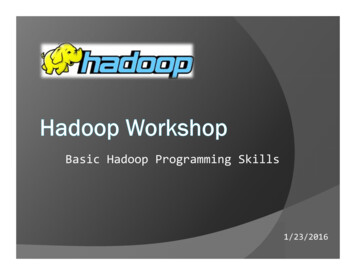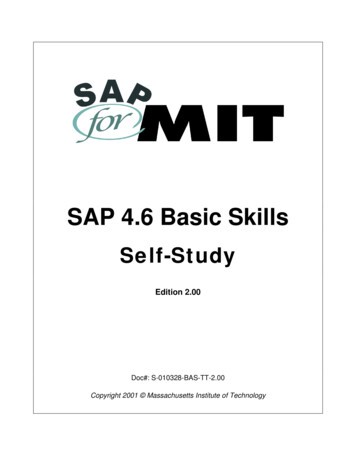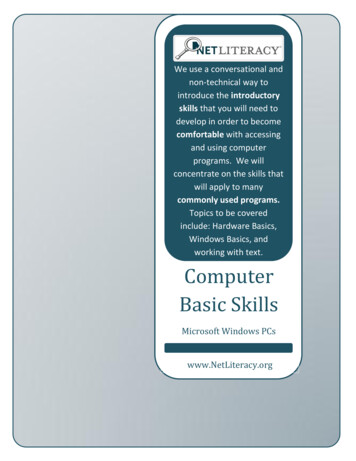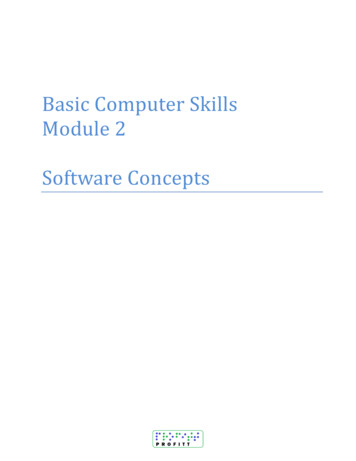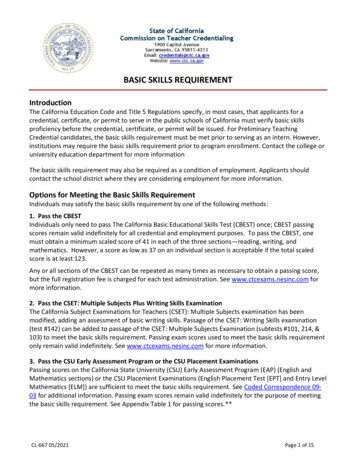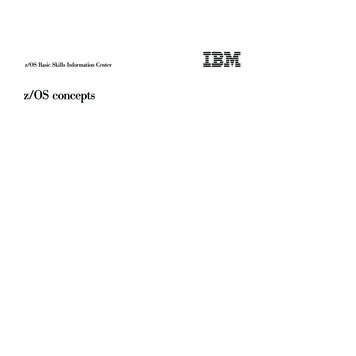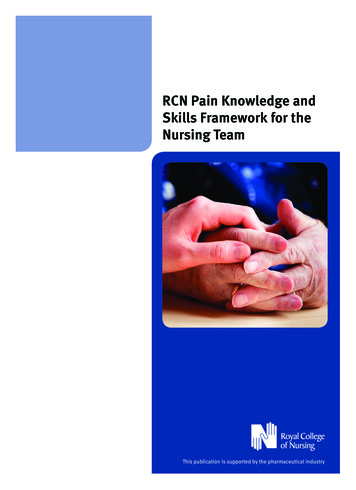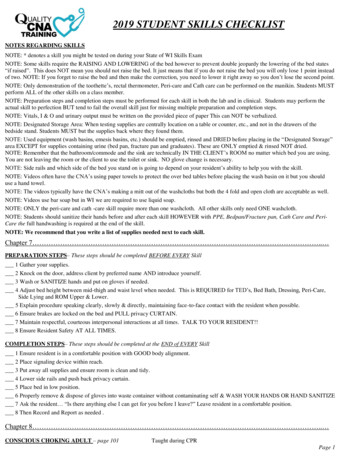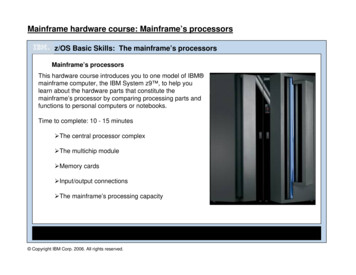
Transcription
Mainframe hardware course: Mainframe’s processorsz/OS Basic Skills: The mainframe’s processorsMainframe’s processorsThis hardware course introduces you to one model of IBM mainframe computer, the IBM System z9 , to help youlearn about the hardware parts that constitute themainframe’s processor by comparing processing parts andfunctions to personal computers or notebooks.Time to complete: 10 - 15 minutes¾The central processor complex¾The multichip module¾Memory cards¾Input/output connections¾The mainframe’s processing capacity Copyright IBM Corp. 2006. All rights reserved.
The central processor complexz/OS Basic Skills: The mainframe’s processorsMainframe’s processors The central processor complexMainframes have one or two metal frames that containspecialized cages, as well as other physical elements.This diagram shows the interior front view of an IBMSystem z9 Enterprise Class (z9 EC) model that has twoframes. The z9 EC is slightly larger than a householdrefrigerator.The central processor complex, or CPC, resides in itsown cage inside the mainframe, and consists of one tofour book packages. Just like its personal-computercounterpart, the motherboard or system board, eachbook package consists of processors, memory, timers,and I/O connections.These collections of hardware parts are called “bookpackages” because you can slide them in or out of theCPC cage almost as easily as you can slide a book onor off a bookshelf. Copyright IBM Corp. 2006. All rights reserved.
z/OS Basic Skills: The mainframe’s processorsMainframe’s processors The book packageIn the System z9, as well as earlier IBM mainframemodels, the book package consists of three distinctareas, one each for: The z9 EC's processors, which are insideone multichip module Memory cards Connections to input/output devicesAll of the book packages plug into a backplane inthe z9 EC's frame. A backplane is a circuit boardthat allows all connected book packages to shareresources. Copyright IBM Corp. 2006. All rights reserved.
The multichip modulez/OS Basic Skills: The mainframe’s processorsMainframe’s processors The multichip moduleThe back of each book package in the centralprocessing complex cage contains one multichipmodule, or MCM. This module contains 16complementary metal oxide semiconductors chips, alsoknown as CMOS chips.CMOS (pronounced see-moss) is a widely usedtechnology for manufacturing processors and memorybecause CMOS chips require less power than otherchips that use only one type of transistor. Transistorsare tiny devices that switch electrical current on and off. Copyright IBM Corp. 2006. All rights reserved.
z/OS Basic Skills: The mainframe’s processorsMainframe’s processors Multichip module sizeThe z9 EC multichip module packs the most memory intothe smallest logic package used in the computer industry.Although each module contains 16 CMOS chips, itmeasures approximately 3.75 by 3.75 inches, or 95 by 95millimeters. That small space also contains over 100glass ceramic layers, approximately 0.3 miles (or 545meters) of internal wiring, and more than 4.5 billiontransistors. Copyright IBM Corp. 2006. All rights reserved.
z/OS Basic Skills: The mainframe’s processorsMainframe’s processors Chip redundancyAs with other hardware elements in the z9 EC, the multichip module provides built-inredundancy; that is, several chips perform the same function or, although specific chips arereserved for specific functions, another chip can take over for a failing chip.For example, if the clock chip fails, another chip in the module can assume the function ofcontrolling processor timing. This capability is called dynamic failover, which is a key factorthat contributes to the mainframe’s continuous availability.In mainframe models before the z9 EC, a clock failure meant that the mainframe was notavailable for any work until the damaged clock chip could be replaced. The z9 EC, however,can dynamically switch to another clock chip without losing a beat! Copyright IBM Corp. 2006. All rights reserved.
z/OS Basic Skills: The mainframe’s processorsMainframe’s processors CMOS chip typesOf the 16 CMOS chips in each z9 EC multichip module: Four are system data or SD chips containing globalmemory that all of the z9 EC’s configured processorsmay access. This shared global memory enables the z9EC’s processors to execute program instructions veryquickly—in a fraction of one nanosecond! One chip is for the storage controller or SC, whichcontrols access to and storage of data in the memory onall of the chips in the book package. Two chips are for the memory storage control or MSC subsystem, which handles thetransfer of data between processor chips and memory cards in the book package. One chip is the oscillator clock, which is abbreviated CLK. The oscillator synchronizes andpaces the z9 EC’s operations. Eight are processor unit or PU chips, which are the workhorses of the z9 EC. Copyright IBM Corp. 2006. All rights reserved.
z/OS Basic Skills: The mainframe’s processorsMainframe’s processors Processor unit chipsEach processor unit chip is designed to provide either one or two physical processor units,and also contains private memory for each processor to store instructions and data.When a z9 EC is installed, it often has a spare processor; that is, an uncharacterizedprocessor unit chip. If the system controllers detect a failing processor chip, it can bereplaced with the spare. In most cases, this switchover can be done without any systeminterruption, even for the application running on the failing processor.Alternatively, spare processor unit chips can be enabled at certain times; for example,during unexpected peak workloads. This capability is called capacity on demand. Copyright IBM Corp. 2006. All rights reserved.
z/OS Basic Skills: The mainframe’s processorsMainframe’s processors General processor characterizationsEach of the eight processor unit or PU chips is characterized by IBM during installation or bycustomers at a later time. The most common characterizations are: Central processor, which is abbreviated CP. This type is for use with an operatingsystem and user applications. Mainframe operating systems are sophisticated products withsubstantially different characteristics and purposes. One mainframe can run more than oneoperating system at the same. The z9 EC supports these operating systems: z/OS z/VM z/VSE Linux for zSeries z/TPF System Assistance Processor, which is abbreviated SAP. Every mainframe has at leastone SAP; larger systems may have several. The SAPs handle input/output subsystemoperations; for example, SAPs manage multiple paths to control units and perform errorrecovery for temporary errors. Copyright IBM Corp. 2006. All rights reserved.
z/OS Basic Skills: The mainframe’s processorsMainframe’s processors Specialized processor characterizationsEach of the eight processor unit or PU chips is characterized by IBM during installation or bycustomers at a later time. Specialized processor characterizations include: Integrated Facility for Linux, or IFL. This type helps reduce software costs on themainframe. It supports new Linux workloads and open standards on the System z platform. System z9 Application Assist Processor, or zAAP. This type also helps reducesoftware costs on the mainframe. It supports the same Java code that can be run on astandard central processor. System z9 Integrated Information Processor, or zIIP. This type handles somedatabase-related workloads. The zIIP reinforces the mainframe’s role as the data hub of theenterprise by helping to make direct access to DB2 more cost effective and reducing theneed for multiple copies of the data. Integrated Coupling Facility, or ICF. This processor type allows a group of mainframesto share data. A coupling facility is, in effect, a large memory scratch pad used by multiplesystems to coordinate work. Copyright IBM Corp. 2006. All rights reserved.
Memory cardsz/OS Basic Skills: The mainframe’s processorsMainframe’s processors Memory capacityThe middle of each book package in the centralprocessor complex cage contains from four to eightmemory cards. Each memory card contains four, eight,or 16 gigabytes of memory.For memory capacity, a gigabyte is 1 073 741 824bytes, which is equivalent to the contents ofapproximately 1 000 lengthy paperback books.If you do the math, one book package containing themaximum number of eight MCMs can provide up to128 gigabytes of physical memory; a z9 EC with themaximum number of four book packages can provideup to 512 gigabytes. Copyright IBM Corp. 2006. All rights reserved.
z/OS Basic Skills: The mainframe’s processorsMainframe’s processors Memory card designEach memory card has two ports, each with a maximumbandwidth of eight gigabytes per second.The memory cards also are hot-pluggable, or hot-swappable,which means that you can add or remove a memory cardwithout powering down the mainframe.These memory cards can be used in many of IBM’s Systemi and System p mainframe and mid-range computers, notjust in the System z9 mainframes.To learn more about the cost and flexibility of memory cards, play this 1-minute video clipfeaturing Dave Anderson, a hardware expert from IBM’s Customer Briefing Center team inPoughkeepsie, New York, where mainframes are designed, manufactured and tested. Copyright IBM Corp. 2006. All rights reserved.
Input/output connectionsz/OS Basic Skills: The mainframe’s processorsMainframe’s processors The mainframe’s I/O superhighwayIn a personal computer or notebook, the processor is connectedto input/output (I/O) devices through a combination of hardwareparts: A bus (USB or SCSI, for example), expansion slots, andcables. Personal computers typically have a very limited numberof expansion slots for peripheral devices, such as printers, DVDdrives, and so on.The z9 EC has similar hardware parts and connections but thedifference in scale is substantial: Comparing PC I/O to mainframeI/O is like comparing a one-lane road to a 10-lane superhighway!To get a better idea of the mainframe’s input/output capacity, justcompare the connections for your personal computer to this viewof the cables connecting the mainframe to its peripheral devices. Copyright IBM Corp. 2006. All rights reserved.
z/OS Basic Skills: The mainframe’s processorsMainframe’s processors Parts of the I/O superhighwayThe front of each book package in the CPC cage is where theinformation superhighway starts. Here you find several key hardwareparts that connect the z9 EC processors and memory to a myriad of I/Odevices. Closest to the processors and memory are slots for up to eightmemory bus adapter or MBA fanout cards. These cards, alongwith a specialized processor chip in the z9 EC’s multichip module,control the flow of data to and from memory in the book package. Each MBA card has two thick self-timed interconnect, or STI,cables that connect the card to the input/output cages in the z9 ECframe. Each cable has a bidirectional bandwidth of 2.7 gigabytesper second. A gigabyte is defined as 1 000 000 000 bytes, whichis equivalent to the contents of approximately 1 000 lengthypaperback books.So a z9 EC with four book packages, each with eight MBA cards and 16 STI cables attached, hasa potential instantaneous bandwidth of 172 gigabytes per second. Copyright IBM Corp. 2006. All rights reserved.
z/OS Basic Skills: The mainframe’s processorsMainframe’s processors I/O capacity and designMany hardware parts constitute the high-speed subsystem thatprovides a path between the mainframe and peripheral devices.The capacity of this subsystem is measured by the number ofavailable channels, which are independent pathways that transferdata. A single z9 EC mainframe can have up to 1 024 individualchannels!The mainframe’s high-speed input/output subsystem includes: Hardware parts inside and connected to the z9 EC’s input/output cages; Specialized input/output equipment on the raised floor, such as input/output controllers; and The memory bus adapter or MBA cards in the z9 EC’s book package, and the self-timedinterrupt or STI cables attached to those cards.To learn more about MBA cards and STI cables, play this 1-minute video clip featuring DaveAnderson, a hardware expert from IBM’s Customer Briefing Center team in Poughkeepsie, NewYork, where mainframes are designed, manufactured and tested. Copyright IBM Corp. 2006. All rights reserved.
The mainframe’s processing capacityz/OS Basic Skills: The mainframe’s processorsMainframe’s processors Scalability and logical partitionsA mainframe’s scalability (that is, its ability to expand resources such as processors, memory,or storage) is measured by the number of system images that the hardware and software aredesigned to support.Each system image, or logical partition, is a subset of hardware resources (processors,memory, and input/output devices) defined to support an operating system. This capability—having multiple systems work together as a seamless system—is called virtualization.Each of these logical partitions, or LPARs, functions as an independent system, just like dualboot systems on your personal computer. And just as you can have different operating systemsboot up on your PC, z9 EC system programmers can configure a different operating system torun on each LPAR.For example, you might have a PC that runs either Windows or Linux, but only one of thosesystems can be running on your PC at a given time. On a z9 EC, several different operatingsystems (z/OS, Linux, and UNIX , to name several) can run simultaneously, each on aseparate LPAR. While PCs and notebooks have a current limit of four physical partitions andfour logical partitions, the z9 EC has many more. Copyright IBM Corp. 2006. All rights reserved.
z/OS Basic Skills: The mainframe’s processorsMainframe’s processors Scalability and processorsIn the z9 EC, the number of system images is not necessarily limited to the physical number ofprocessor chips in the mainframe. In fact, each chip is either a single-core or dual-core chip;single-core chips support only one processor, while dual-core chips can support twoprocessors.Depending on the number of book packages in the CPC cage, a single z9 EC can be logicallypartitioned into as many as 54 processors (sometimes called “engines”) each with thecapability of executing 600 million instructions per second (MIPs).To express these processing and scalability measurements, you often hear people saysomething like “The z9 EC has a 600-MIP engine that scales up to a 54-way.”Although this characteristic of mainframes is not truly comparable in personal computers, youcould say that the z9 EC’s scalability is like having multiple Intel chips in your PC instead ofonly one chip. Copyright IBM Corp. 2006. All rights reserved.
Trademarksz/OS Basic Skills: The mainframe’s processorsThe following terms are trademarks of the IBM Corporation in the United States or other countriesor both:IBM*z/OS*IBM eServerz/VM*System iz/VSESystem pzSeries*System z9* Registered trademarks of IBM CorporationJava and all Java-based trademarks are trademarks of Sun Microsystems, Inc. in the United States, othercountries, or both.Microsoft, Windows, Windows NT, and the Windows logo are trademarks of Microsoft Corporation in the UnitedStates, other countries, or both.Intel, Intel logo, Intel Inside, Intel Inside logo, Intel Centrino, Intel Centrino logo, Celeron, Intel Xeon, IntelSpeedStep, Itanium, and Pentium are trademarks or registered trademarks of Intel Corporation or its subsidiariesin the United States and other countries.Linux is a registered trademark of Linus Torvalds in the United States, other countries, or both.UNIX is a registered trademark of The Open Group in the United States and other countries. Copyright IBM Corp. 2006. All rights reserved.
z/OS Basic Skills: The mainframe’s processors Mainframe’s processors Specialized processor characterizations Each of the eight processor unit or PU chips is characterized by IBM during installation or by customers at a later time. Specialized processor characterizations include: I
